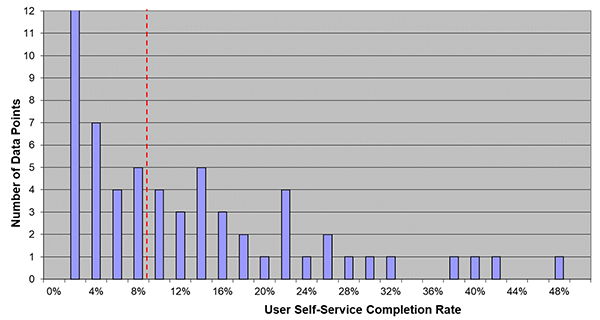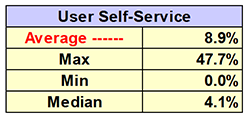Each month, I highlight one Key Performance Indicator (KPI) for service and support. I define the KPI, provide recent benchmarking data for the metric, and discuss key correlations and cause-and-effect relationships for the metric. The purpose of the column is to familiarize you with the KPIs that really matter to your organization and to provide you with actionable insight on how to leverage these KPIs to improve your performance! This month, I look at user self-service.
User self-service measures the percentage of incidents that are self-resolved by the user, without the assistance of a live agent. Let’s say, for example, that the agents on a particular service desk handle 4,000 incidents per month through voice, chat, and email. Another 1,000 incidents per month are resolved through user self-service (e.g., through a self-help portal that includes a password reset tool). For this hypothetical service desk, the self-service rate is 1,000 self-service incidents ÷ 5,000 total incidents = 20% user self-service.
User self-service is typically driven by the adoption of technologies that enable users to resolve their own incidents. The most common of these technologies include password reset tools, online FAQs, and self-help portals that give users access to the solutions knowledge base. Some of these tools are quite powerful and offer the users robust search capabilities for finding a solution to their specific need.
Why It’s Important
Last year, the average cost of resolving an incident at level 1 in North America was about $22. If some of these incidents can be deflected to self-service, that reduces the headcount requirements and hence the cost of the service desk. As the self-service rate increases, both shift left and channel mix come into play. Shift left reduces the total cost of ownership in service and support, as illustrated in the first figure below.

And deflecting contacts into the self-service channel averages down the cost per ticket because self-service incidents are much lower cost than walk-up, voice, or chat incidents, as illustrated in the next figure.

Years ago, some in the industry were predicting that user self-service tools would become so powerful that level 1 support would become obsolete. That has not happened yet, and probably won’t happen for quite some time because self-help tools are currently not powerful enough to rival the knowledge, experience, and troubleshooting capabilities of a human expert.
Additionally, there are limitations on what can and should be resolved through self-service. As technology advances, incident complexity also increases. Developing knowledge articles that keep up with technology, and offering them in a friendly, searchable format for user self-service is a very challenging task. Moreover, you probably don’t want your users spending a lot of time searching for solutions to their IT problems.
Take the case of a user who spends two hours self-resolving a how-to issue for a proprietary business application. If that user could have gotten the same solution in 15 minutes by contacting the service desk, clearly that is the better support channel. This is the primary reason that most incidents resolved through self-service tend to be fairly straightforwardpassword resets, desktop application tutorials, and the like. At MetricNet our rule-of-thumb is that a user should not spend more than 10 minutes at a time trying to self-resolve an incident. Any more time than that in the self-help portal is probably costing the enterprise more in lost user productivity than it is saving.
It is worth noting that as the self-service rate increases, organizations typically see an increase in the cost per agent-assisted contact. The reason for this is fairly obvious. The incidents resolved through self-service tend to have short handle times when resolved by an agent. As these lower-handle-time incidents are deflected into the self-service channel, the average complexity, and hence the average handle time of the incidents that continue to be handled by live agents will increase. This, in turn, increases the average cost of an agent-assisted incident.
Benchmark Data for Self-Service Completion Rate
MetricNet’s benchmarking database shows that the average self-service completion rate for service desks worldwide is 8.9%. This number varies widely, however, from a low of 0% for many service desks with no self-service capabilities, to a high of 48%. Not surprisingly, the vast majority of these self-resolved incidents are password resets. In fact, password reset tools are one of the most common technologies found in IT service and support and have generally been shown to have a very favorable ROI.
The figure below shows the distribution of self-service completion rates for a representative cross-section of service desks worldwide.


Please join me for next month’s Metric of the Month: Channel Mix, a newer but increasingly important metric that has implications for shift left and total cost of ownership.









